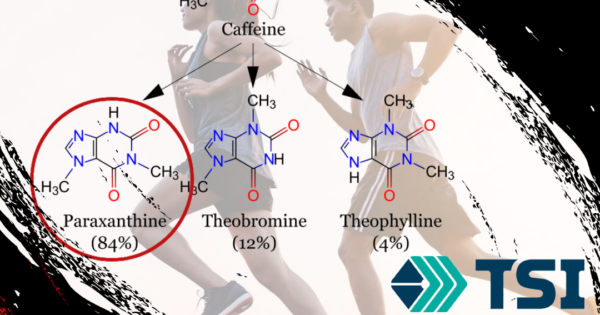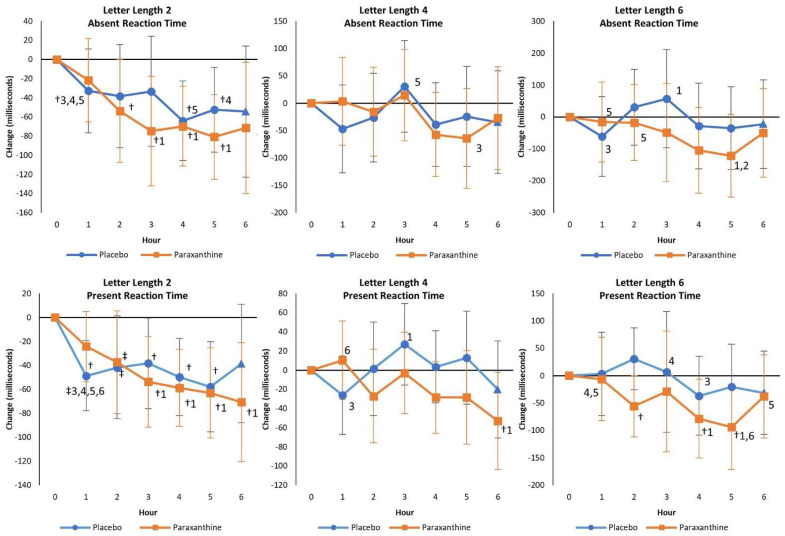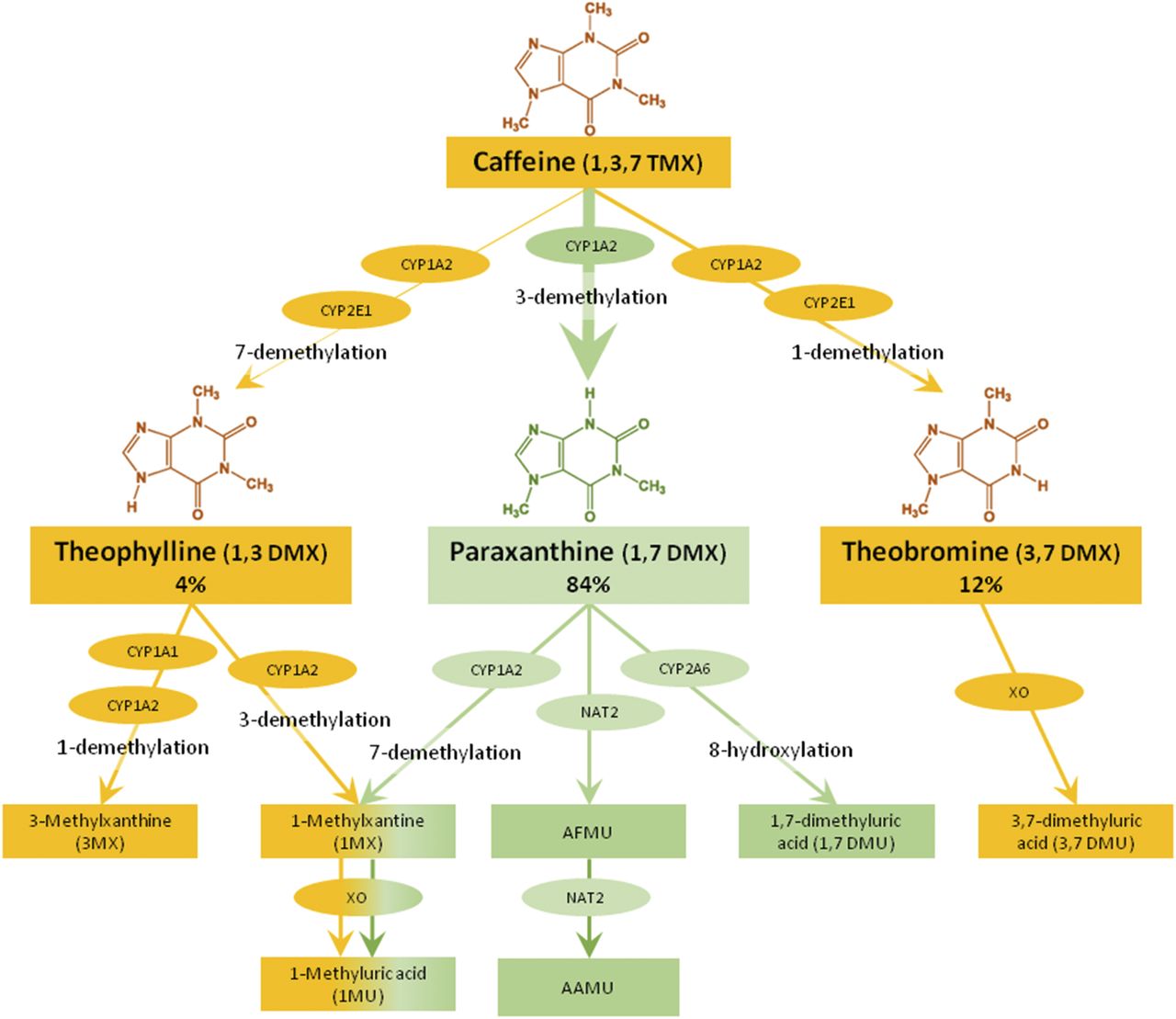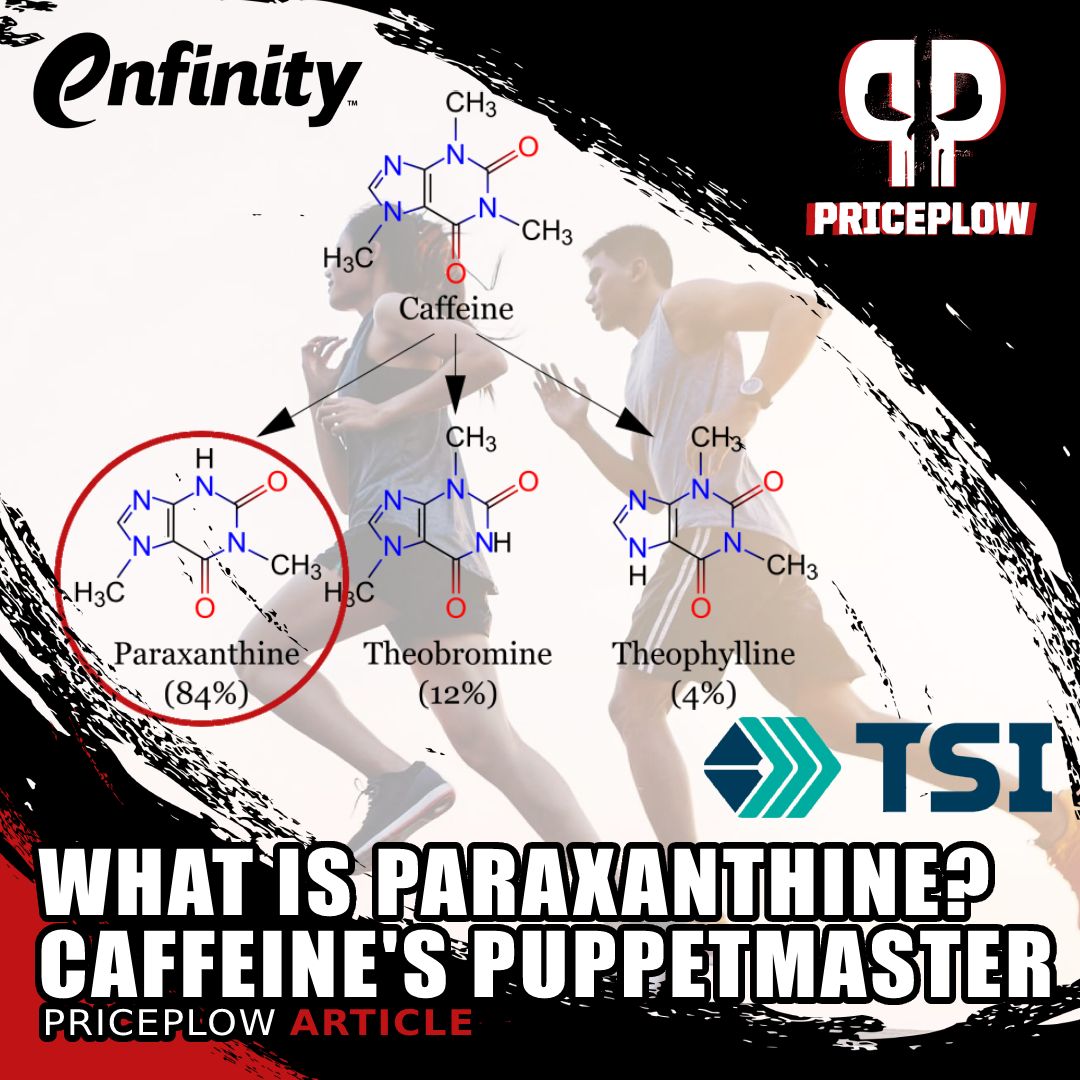Caffeine’s Major Metabolite for Laser-Targeted Energy
CAFFEINE.
A whopping 93% of American adults drink some sort of caffeinated beverage on a daily basis.[1]
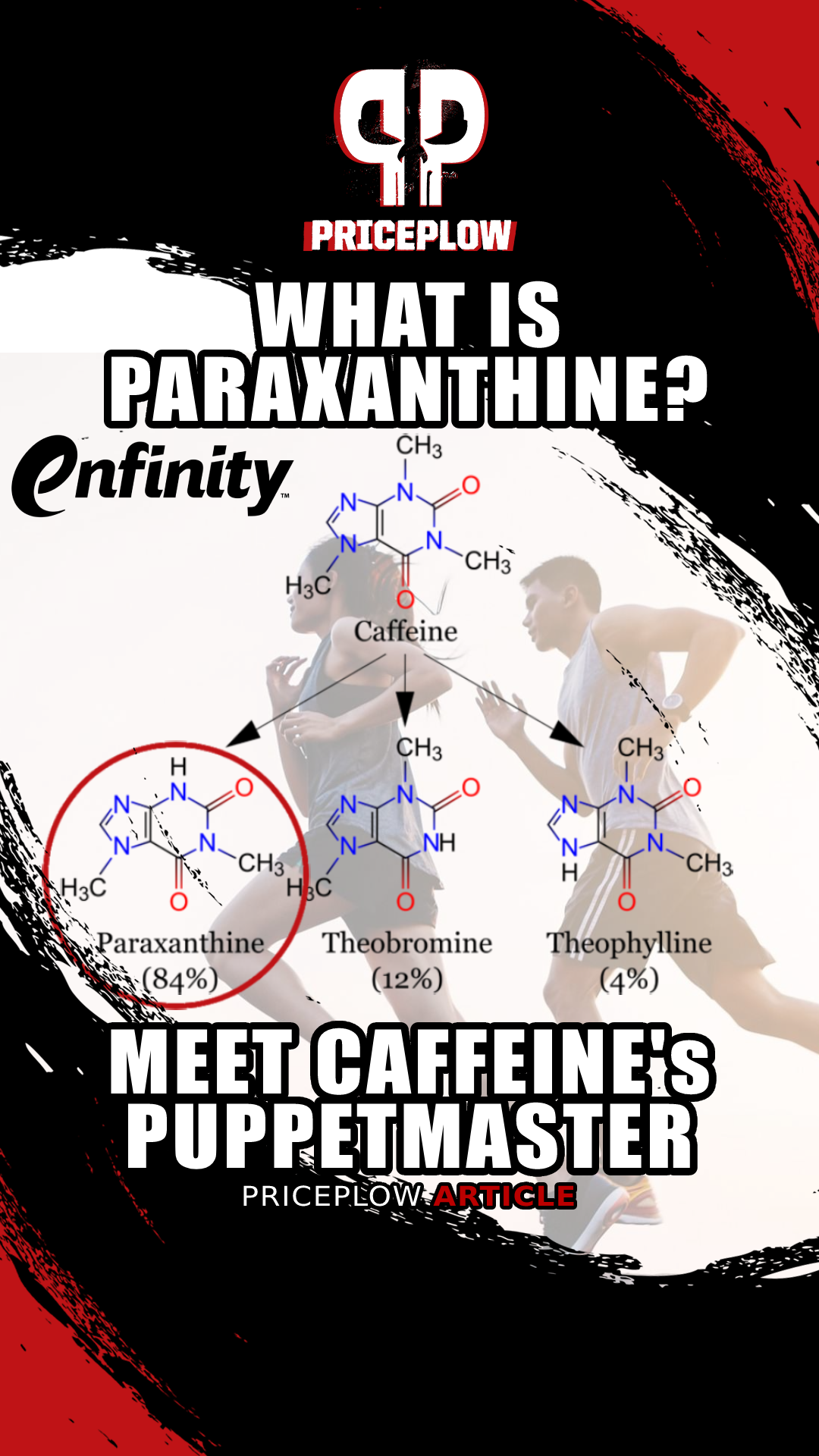
Paraxanthine is the primary metabolite of caffeine, providing most of caffeine’s beneficial effects. Now you can take it directly with enfinity!
So, we all pretty much love it, yet some of us hate it while loving it.
If you fall into the latter category, and have a tortured relationship with the western world’s drug of choice, read on, because this article is for you.
Would the Real Caffeine Please Stand Up?
So why do we love caffeine so much? You’re probably thinking, “because it gives us energy”. But that isn’t exactly what caffeine does.
How caffeine works
In short, caffeine works by inhibiting adenosine,[2,3] which builds up in the brain as ATP (adenosine triphosphate) is consumed for energy,[4] eliciting wakeful effects. It can also inhibit phosphodiesterase, the enzyme that breaks down cyclic adenosine monophosphate (cAMP),[2,3] ultimately stimulating the metabolism a bit by liberating free fatty acids (FFAs) from body fat to be used for energy.[5]
This process where caffeine drives the release of fatty acids for energy is called lipolysis and is a main reason caffeine has long been touted as a useful supplement for sports and weight loss.
The problem — and solution — to our caffeine problem
But as we’ve come to learn over the years, we don’t all metabolize caffeine the same, and many of us experience unwanted effects and tolerance build-up, especially as dose increases.[6]
There’s good news, though — it turns out that many of the beneficial aspects of caffeine aren’t from caffeine itself, but instead from caffeine’s main metabolite: paraxanthine. Thanks to modern science, we can zero in on this metabolite, skipping some of the unwanted side effects of caffeine’s other metabolites. This represents a major paradigm shift, as we learn that caffeine isn’t necessarily what we seek when we’re consuming it!
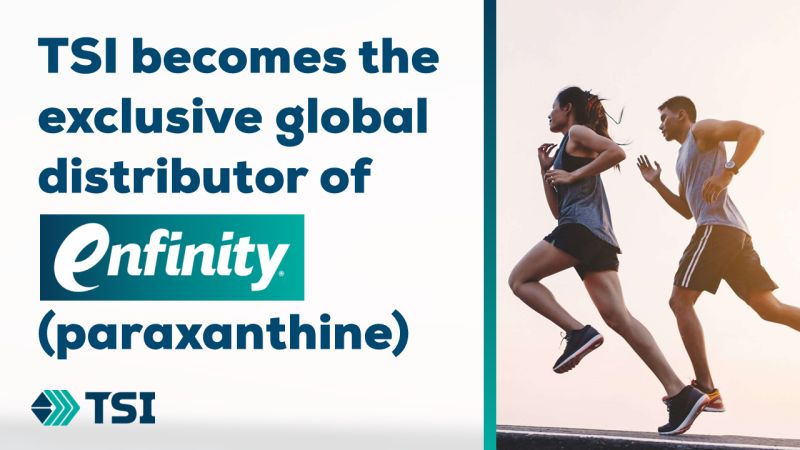
Announced on September 1, 2023, TSI Group is the Exclusive Global Distributor of enfinity paraxanthine
In this article, we focus on paraxanthine, explaining the science behind the potent caffeine metabolite, and why supplementing with it may be a better option than caffeine itself. It’s marketed as enfinity® and is exclusively distributed by TSI Group, the same company that’s known for Peak ATP and myHMB.
The first products with enfinity® were MuscleTech’s iQ Series supplements, including the EuphoriQ pre-workout and Burn iQ fat burner, but paraxanthine can now be formulated into more supplements, so this is a good time to recap the benefits of paraxanthine.
You can sign up for our enfinity® news alerts below, and then keep reading as we explore this fascinating molecule:
Subscribe to PricePlow’s Newsletter and Alerts on These Topics
Paraxanthine: The Molecule Responsible for Many of Caffeine’s Benefits
Caffeine’s three major metabolites are paraxanthine (~84%), theobromine (~12%), and theophylline (~4%).
The latter of these two metabolites have much longer half-lives — 6.2 hours for theobromine and 7.2 hours for theophylline, on average.[7] Since these metabolites are stimulatory, they can lead to unwanted side-effects, especially for slow metabolizers or if the caffeine’s taken too late.
Paraxanthine, however, has an average half-life of 3.1 hours, while caffeine itself averages 4.1 hours.[7]
But those are just averages, and that leads us to the next point – caffeine metabolism is not consistent across individuals:
Fast, Medium, and Slow: Bio-individuality of caffeine metabolism
These half-lives are misleading, however. Reason being, there is great bio-individuality. This is largely genetic: The CYP1A2 gene is primarily responsible for demethylating caffeine into its metabolites,[8-10] and this gene’s activity varies greatly within and between individuals, especially with respect to caffeine metabolism.[11-23]
For instance, from person-to-person, caffeine’s half-life can actually be anywhere from 1.5-10.5 hours. In fact, research has shown that caffeine clearance can vary by as much as 40x between individuals![11,12]
This means that if you’re a slow metabolizer, you can still have caffeine in your system three days later! Talk about poor sleep. With this, we can already see the promise of a supplement with lower side effects — but what effects does paraxanthine itself have?
-
Paraxanthine and Lipolysis
In 1990, researchers noted that it takes a lot more caffeine to trigger lipolysis in vivo (in actual living organisms) than it does to trigger lipolysis in vitro (in isolated, non-living cells from those organisms).[27]
Because macroscopic organisms like mammals can have biological systems and organs that metabolize substances like caffeine, whereas cell cultures cannot, researchers began to wonder whether maybe some metabolite of caffeine was driving lipolysis – rather than caffeine itself.
So in 1990, some researchers set out to answer that question.[27] They gave intravenous caffeine to a group of 10 men and continuously monitored their blood levels of caffeine, paraxanthine, and FFA for the next three hours.[27]

Caffeine has three major metabolites, and one of them (paraxanthine) does the heavy lifting. The other two have very long half-lives, which could be interfering with your experience. Image courtesy Wikimedia
In the end, they discovered that yes, paraxanthine — and not caffeine — appeared to be driving lipolysis.[27] Specifically, there was a “high positive correlation” between the appearance of paraxanthine and levels of FFA in the bloodstream of the volunteers.[27]
We hope to see more specific data on this in the coming months and years — stay tuned to PricePlow. Until then, let’s keep moving forward:
-
Paraxanthine and Adenosine
In a 1995 crossover design study, researchers gave a group of 12 subjects equivalent doses of caffeine and paraxanthine, and measured their physiological response to the drugs. They discovered that caffeine and paraxanthine had similar effects on blood pressure and levels of epinephrine (adrenaline) in the subjects’ blood.[28]
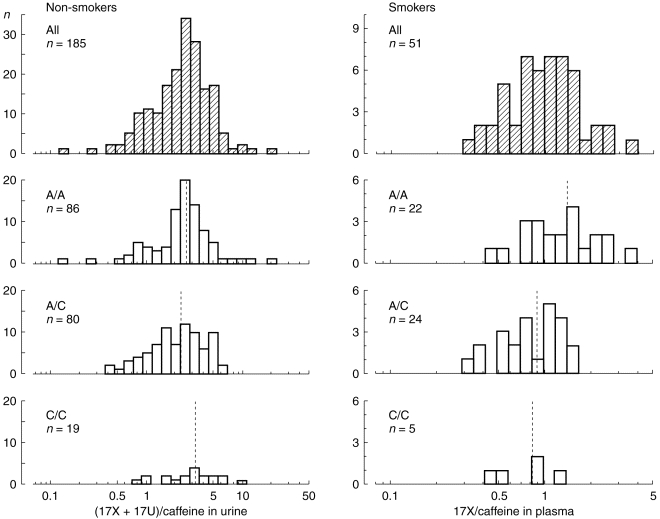
In this study, ~46% of all participants were fast caffeine metabolizers (A/A),[13] meaning more than half of individuals aren’t optimal caffeine consumers!
But more interestingly, the researchers realized that paraxanthine was an adenosine antagonist, just like caffeine.[28]
So in addition to its effects on lipolysis (which is mediated primarily by epinephrine), paraxanthine also reduces fatigue by the same mechanism of action as caffeine – which is especially interesting because fatigue reduction is far and away the most common reason for caffeine consumption in the first place.
As we dig into the research literature, we find the effects of caffeine and paraxanthine looking more and more similar.
-
Paraxanthine and Dopamine
Many people consume caffeine because they’re trying to tap into the dopaminergic benefits of caffeine consumption. The dopamine upregulation caused by caffeine (and other drugs) is known to increase motivation,[29] alertness,[29] and psychomotor competence.[30]
It turns out that paraxanthine also modulates the dopamine system.[31] Much like caffeine itself, paraxanthine protects dopaminergic neurons against stress and cell death,[32] theoretically lowering the risk of dopamine disorders like Parkinson’s disease (which coffee has long been thought to do[33]).

A brief intro to the science of paraxanthine / enfinity. Image courtesy of MuscleTech, who created the supplement with the iQ Series of supplements.
Paraxanthine also simply upregulates dopamine, making more of it available for the brain to use – in fact, paraxanthine has been described by researchers as more efficient in its pro-dopaminergic activity than caffeine,[34] at least in particular regions of the brain.
Anecdotal evidence seems to back this up too — reviews on early paraxanthine-based supplements (which do have other confounding ingredients, admittedly) consistently report on mood and confidence boosts similar to that of similar caffeine-based supplements.
-
Paraxanthine and Cognition
One of the reasons we reach for caffeine during the workday is the mental boost that we seem to experience after taking caffeine, which makes it easier to focus and be productive.
But although many people swear up and down that they think and work better under the influence of caffeine, the empirical evidence supporting caffeine’s nootropic properties has been equivocal.[35] Caffeine sems to support some cognitive functions, like working memory, to a very limited extent, but large doses of caffeine can actually worsen cognition – and let’s be honest, none of us are stopping at one cup of coffee.
So the question now is: Could paraxanthine confer the benefits that most of us are trying to get from caffeine?
A recent study, published in 2021, set out to answer just that question.[36]
In a double-blind, placebo-controlled, randomized study – a study design that’s considered the gold standard in medical journals – researchers gave 13 healthy men and women either a trademarked preparation of paraxanthine (known as enfinity®) or a placebo.[36] The subjects’ cognitive performance was then measured hourly for 6 hours afterwards with a series of tests.[36]
A week later, the experiment was repeated with the same group – except this time, the group that had previously taken paraxanthine got the placebo, and vice-versa.
The result was that in the “go/no-go” task, a test in which subjects must respond to the “go” stimulus but not respond (i.e., inhibit their response) to the “no-go” stimulus, the paraxanthine group had significantly lower reaction times at every point in the data collection.[36]
The paraxanthine group also did better in a straight up reaction time test, although the effect was not as pronounced.[36]
But the big result from this study was that in a card sorting test, the paraxanthine group made 17.5% fewer errors than the placebo group by the 6 hour mark.[36] Moreover, the number of “perseverative errors” was 32.8% lower – meaning that the paraxanthine group learned from their mistakes better than the placebo group.
Sounds pretty nootropic to us.
-
Paraxanthine and the Liver
Coffee is also famous for its ability to protect the liver – in people with existing liver disease, as few as two cups of coffee per day may lower the risk cirrhosis and fibrosis.[37] The power of coffee to protect the liver, perhaps even reducing a person’s risk of liver cancer, is significant enough that researchers have even described coffee as the “magical bean for liver diseases.”[38]
But by now we’re smart enough to ask: How much of this liver-protective effect is being caused by caffeine’s primary metabolite, paraxanthine?
According to a 2009 study, paraxanthine is a powerful anti-fibrotic compound, capable of preventing connective tissue from growing in places where it doesn’t belong, such as the liver.[39]
Specifically, paraxanthine is the best of all the caffeine metabolites at preventing fibrosis.[39]
It’s worth noting that the CYP1A2 gene is found only in the liver,[17] forcing the liver to perform potentially unnecessary work when processing caffeine.
So Does Caffeine Itself Do Anything?
Yes – don’t misunderstand, caffeine is itself biologically active, and although it might not trigger lipolysis the way that paraxanthine does, it remains a potent adenosine inhibitor,[28] ergogenic aid and more. Caffeine has independent effects on the dopamine system in the brain,[40] making dopamine more abundant[41] and biologically active.
So it’s not that all the benefits of caffeine are caused by paraxanthine instead – it’s more the case that there’s a broad overlap between the effects of these two substances.
But for many people who want the benefits associated with caffeine, paraxanthine consumption may be a better strategy than taking caffeine itself.
Why it Matters for the Consumer
We pretty much all know that when you drink coffee, or some other caffeine-containing beverage, your caffeine blood levels will rise in response. But few of us understand the mechanism by which the body clears caffeine from the bloodstream, bringing levels back down.
That mechanism is an enzyme called cytochrome P450 1A2 (CYP1A2).[8-10] This is the enzyme that converts caffeine into its metabolites, of which paraxanthine is only one.
The other two, again, are theobromine and theophylline. And, as introduced earlier in this article, CYP1A2 activity varies from individual to individual according to their inherited genetics.[11-23]

MuscleTech’s Raza Bashir and Ingenious Ingredients (and NNB Nutrition CSO) Shawn Wells join the PricePlow Podcast for Episode #072 to talk about MuscleTech’s new iQ Series launch, using enfinity Paraxanthine!
Recall from your high school biology classes that genetic traits are determined by a combination of two alleles – in this case, the alleles are “fast” and “slow” caffeine metabolism. If looking at the CYP1A2 rs762551 polymorphisms, there are three variations:[23]
- ‘AA’: Fast metabolizer
- ‘AC’: Intermediate metabolizer
- ‘CC’: Slow metabolizer
If both of your CYP1A2 alleles are fast, then congratulations: you can drink basically as much coffee or caffeine as you want. In fact, if you’re a fast caffeine metabolizer, heavy coffee consumption is associated with a lower risk of hypertension and cardiovascular disease.
But if one of your two alleles are the “slow” copy of the gene, or both, then you’re going to have problems with caffeine use, potentially big problems.
Where you fall on the caffeine metabolism spectrum can make or break your relationship with the substance. For example, regular coffee consumption raises the risk of high blood pressure in “slow metabolizers” – but not in fast metabolizers.[42]
In fact, in fast metabolizers, caffeine may even be protective against high blood pressure, as researchers have found an inverse correlation between a person’s blood pressure and his or her excretion of caffeine and paraxanthine.[43]
If this sounds unfair, that’s because it totally is.
But fortunately for you, there’s a potential solution. Supplement the compound that gets metabolized more consistently across a broader range of users!
Paraxanthine Is Less Toxic Than Caffeine
Even though paraxanthine is metabolized through the same pathway as caffeine[9] – the CYP1A2 enzyme – research has consistently shown that paraxanthine has less toxicity and causes less anxiety in its users than caffeine does.[28] In fact, no major toxicity from paraxanthine has been found.[44]
This means that even if you’re a “slow paraxanthine metabolizer,” the downside of high paraxanthine levels in your blood is going to be a lot smaller than what you’d feel if you took an equivalent amount of caffeine.
Paraxanthine also has a shorter half-life than caffeine – about three hours, on average, compared to caffeine’s four. So even if you’re a slow metabolizer, you will still clear paraxanthine faster than you clear caffeine.
Paraxanthine Doesn’t Convert to Theobromine
The biggest metabolite of caffeine, after paraxanthine, is theobromine. Compared to caffeine and paraxanthine, theobromine doesn’t do much in the way of central nervous system (CNS) stimulation,[45] but has much bigger effects on heart rate than caffeine or paraxanthine do.[45] So basically, theobromine is giving you the main downside of caffeine (adversely affected cardiovascular function) without much of the upside (wakefulness and vigilance).
Paraxanthine Doesn’t Convert to Theophylline
Part of the reason that paraxanthine is less “toxic” than caffeine is that by taking pure paraxanthine, you sidestep the conversion of caffeine to its next biggest metabolite, theophylline, which is known to cause diarrhea, nausea, and irregular or rapid heartbeat.[46] The conversion of caffeine to theophylline is responsible for many if not most of caffeine’s negative side effects, so avoiding it altogether is a very good thing indeed.
Where to Get Paraxanthine?
Discussed above, there’s a paraxanthine ingredient named enfinity® that’s been studied in new clinical research.[36] enfinity® is the industry’s only paraxanthine ingredient, which has been patented by the group at enfinity energy LLC[47] and is distributed by TSI Group. Many of PricePlow’s readers know TSI Group from our scientific coverage of Peak ATP and myHMB.
TSI Group is bringing paraxanthine to the market in a stable, lab-tested ingredient – to provide the better parts of caffeine to a customer base who’s been anxious to try something better than caffeine. It’s non-GMO, vegan, kosher, and allergen-free.
We’re excited to see enfinity® in energy drinks, pre-workout supplements, mood enhancers, thermogenic fat burners, nootropics, and far more. At the bottom of this article, you can sign up to get our enfinity® alerts so that you’re notified when a new supplement comes out using it.
Conclusion
It seems too good to be true – a caffeine-like dietary supplement with basically none of the undesirable side effects of caffeine. And of course, since paraxanthine research is still pretty preliminary, it could turn out to be too good to be true… but at this point, we really don’t think that’ll be the case.
If you suspect that you’re a “slow metabolizer”, consider establishing this empirically, either by a genetic test, or by having the paraxanthine-to-caffeine ratio of your blood measured in a laboratory setting.[48] But many of you who can’t take caffeine anywhere remotely late in the day already know.
And if you do turn out to be a slow metabolizer, give paraxanthine a try – your heart and brain will thank you for making the effort.

